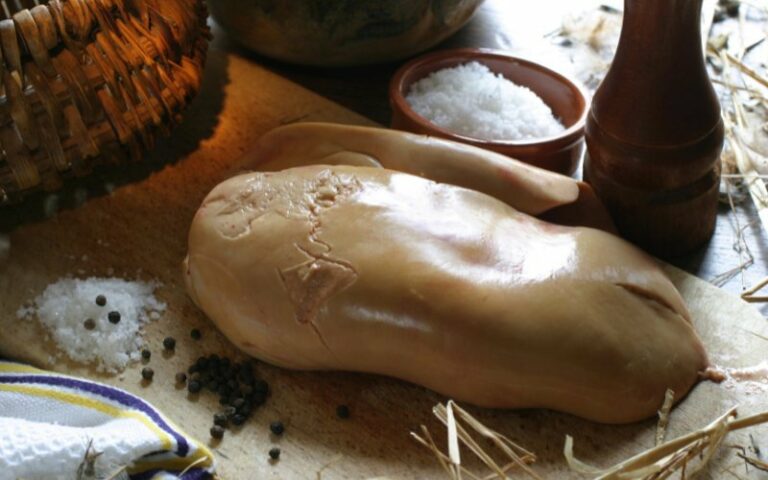Top 11 Facts About Foie Gras
Foie gras has an intriguing history behind it. Today, it remains a big part of French culture in France and for those who want to experience the culture there. However, it’s a very controversial delicacy due to the way it is produced.
Some people are convinced that supporting foie gras farmers equals supporting animal abuse. But there are ethical ways to produce foie gras – the force-feeding techniques, known as gavage, used to produce it aren’t inherently evil. Fortunately, there are a few small foie gras farms throughout the world that treat their animals well. If you’re interested in learning some fascinating foie gras facts, you’re in luck – there are many fascinating ones you probably don’t know about. Here are some of the best.

“Foie Gras” Literally Means “Fatty Liver”
The term “foie gras” is French for “fatty liver”, which is exactly what foie gras is. It’s made from the livers of ducks or geese that have been overfed for two or three weeks before being killed. This overfeeding causes their livers to expand to ten times their normal size and to increase from five percent fat to fifty percent fat.
This Delicacy Dates Back to Ancient Egypt
Foie gras is usually associated with the French, so this is a foie gras fact that not many people know about – historians believe that the delicacy originated in Egypt. They found an image of farmers force-feeding geese in an ancient Egyptian tomb. Since then, foie gras has been enjoyed by many cultures and peoples throughout the world, including the Greeks, Romans, Jews, Gauls, French, and Americans.
Foie Gras Has Always Been an Expensive Luxury
Despite its prevalence in France, foie gras is expensive to raise and purchase, especially if you get it from a small, ethical farm. Foie gras farms, even those that are trying to raise their animals well, get a lot of opposition from protest groups. And producing foie gras is simply an expensive process – raising birds out to full size requires a good deal of grain, equipment, and work.
Foie gras has always been considered a delicacy – it was named the “dish of kings” by Louis XVI. In modern times, it’s become more accessible to the general population, but it’s still quite expensive. Depending on where you purchase it, foie gras costs anywhere between $40 and $80 per pound.
Foie Gras is Banned in a Number of States and Countries
Foie gras is pretty controversial, and some places have gone so far as to ban it from being produced and/or imported from other countries. In the United States, foie gras is banned in California and New York City. Other countries that ban foie gras production include the United Kingdom, Italy, Germany, Poland, and Norway, among many others.
Birds Get Naturally Fatty Livers Through Overeating in the Wild
Foie gras is produced by forcing a duck or goose to eat too much. This extra food increases the liver’s size and fat percentage. When people hear the term “force-feeding”, they immediately think that foie gras production must be unethical.
However, ducks and geese overeat in the wild to put on fat and prepare themselves for migration. Birds have to be able to store energy to survive in the wild, and they do this through fat storage. Each year, many migrating species eat enough to double their body weight and prepare for long periods of time without food.
There are actually foie gras farms that don’t force-feed at all. They simply take advantage of this natural habit of overeating and butcher wild geese after they prepare for migration.
Not All Foie Gras Farms Are Inhumane
Foie gras farms that treat their animals horribly do exist. We’ve all seen and read about how birds are trapped in wire cages, covered in their own feces, sick with uncontrolled diseases, and never allowed to see the sunlight. These are awful conditions for any animal to live in, and it’s understandable that many people oppose foie gras production when it’s done in this way.
The problem is that most people who condemn foie gras are only looking at these farms. They often make it sound as though all foie gras is produced this way, and that purchasing any kind of foie gras supports businesses that don’t care about animals’ wellbeing.
However, there are small farms that raise healthy, happy birds who live a good life. Even if a foie gras farm uses gavage to fatten geese and ducks, there are humane ways to do this as well. On these farms, birds aren’t stuffed full of more food than they can process. Contrary to popular opinion, these ducks and geese are still able to walk, make noise, and carry on with their normal lives.
Force-Feeding Doesn’t Hurt the Bird
As humans, we have a tendency to humanize animals. But waterfowl aren’t human and they function much differently from us. Because they live in the wild, they are incredibly adaptable and they can adjust to a variety of circumstances, both in the wild and on a farm.
It’s true that, on foie gras farms, birds are forced to eat more than they’d normally eat in the wild. But any animal on any farm gets more food than it would get in the wild. The best foie gras farms find a balance; they feed the birds more food than they need, but they avoid overfeeding the birds to the point of discomfort or stress.
Many people don’t like the fact that gavage involves putting a tube down a bird’s throat. But you have to remember that ducks, geese, and other birds don’t have teeth. This means that, in the wild, they’re swallowing food much larger and more uncomfortable than a tube. So the mechanics of force-feeding, when done correctly, really don’t bother them at all.
Food is deposited in a bird’s crop after it swallows. These crops can hold far more food than they’re given during a force-feeding session. As a result, the bird is perfectly comfortable digesting the extra food it’s been given.
Finally, a tube down a bird’s throat doesn’t affect its breathing at all because its respiratory system is completely separate from its digestive system, unlike in humans. As a result, having a tube down its throat isn’t uncomfortable for a duck or goose.
Most Foie Gras Farms Raise Moulard Birds
Moulard birds are the most popular type of bird for foie gras production. Moulard birds are a cross between Muscovies and Pekin ducks.
Muscovies are very hardy, aggressive, and able to adapt to a variety of climates. They don’t migrate and thus don’t have to overeat.
Pekin ducks were bred from wild mallards. As a result, though they no longer migrate, they retain many of the characteristics of a migratory species, including metabolism processes. They tend to be small and plump, as well as sociable – groups of Pekins will hang out close together even if they have lots of space.
When Pekins are crossed with Muscovies, you get a Moulard bird which has characteristics from both species that align with the conditions of a foie gras farm. Moulard birds are large, making them great for meat production. They also enjoy the company of other birds, so they are content and safe living in close quarters. Finally, Moulards don’t feel the need to migrate, but they still retain the metabolism necessary for overeating before migration.
As a result, these birds are perfectly happy to grow up on a foie gras farm and they’re a practical choice for farmers as they possess the ideal characteristics.
Foie Gras Can Be Grown In Labs
Researchers have responded to protests against the cruelty of traditional foie gras, and they’ve figured out how to grow foie gras in a lab. It doesn’t require gavage or slaughter – because only the liver is grown out.
The lab liver is made from stem cells from a fertilized egg. These cells are fed until they form tissue.
Researchers are still perfecting this method, but it might end up replacing many of the unethical foie gras farms throughout the world. At the moment, however, it’s more expensive and less efficient than traditional methods.
There Are a Variety of Foie Gras Dishes
Foie gras can be made from goose or duck livers, which taste slightly different. There are also different grades of foie gras – grade A, grade B, and grade C – that measure quality.
Foie gras can be purchased whole and cooked, without any other ingredients added. It can also come as a mousse, pureed and whipped together. Foie gras can be combined with other meats to make pate, a smooth spread that is served on bread or crackers. You can purchase foie gras partially cooked if you want to experience it as close as possible to its original form. Finally, foie gras can be sterilized and preserved for a long shelf life.
Foie Gras Can Be Preserved For Years
When you buy foie gras at a store, restaurant, or from a farmer, you can usually only keep it for a few days in the fridge or up to a year if it’s frozen. However, if foie gras is sterilized and stored correctly, it can have a shelf life of up to four years. To store foie gras for a long period of time, it must be cooked at a high temperature to sterilize it. It’s traditionally preserved in its own fat and kept in a jar. Some people believe that foie gras is like wine and gets better with age.



